(Otimizado para dispositivos de tela pequena)
Downtown, main square - Pécs, Hungria
Quando você clica em:
Clique nas imagens!
-
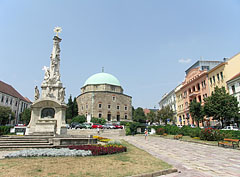
Baroque Holy Trinity column
Data de fotografia: 20062006
Criado por: Robert Németh
Modelo da câmara: Konica Minolta Dimage A200
Pécs, Hungria
-
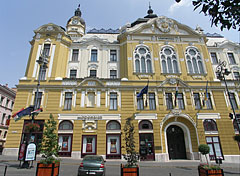
Facade of the City Hall of Pécs
Data de fotografia: 20062006
Criado por: Robert Németh
Modelo da câmara: Konica Minolta Dimage A200
Pécs, Hungria
-

The eclectic style County Hall of Baranya
It was built in 1897, originally it was the headquarters of Pécs-Baranya Central Savings Bank ("Pécs-Baranyai Központi Takarékpénztár").
Data de fotografia: 20062006
Criado por: Robert Németh
Modelo da câmara: Konica Minolta Dimage A200
Pécs, Hungria
-
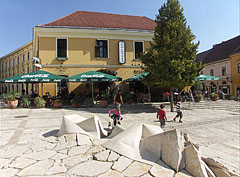
In 2001 the Jókai Square was renovated, it became a pedestrian zone and got a nice cleaved limestone cladding
Data de fotografia: 20092009
Criado por: Robert Németh
Modelo da câmara: Konica Minolta Dimage A200
Pécs, Hungria
-

Zsolnay fountain (memorial well for Vilmos Zsolnay), and
Data de fotografia: 20062006
Criado por: Robert Németh
Modelo da câmara: Konica Minolta Dimage A200
Pécs, Hungria
-

Mosque of Pasha Qasim (today Roman Catholic Church, formerly called St Bartholomew's Church) by night
Data de fotografia: 20052005
Criado por: Robert Németh
Modelo da câmara: Konica Minolta Dimage A200
Pécs, Hungria
-
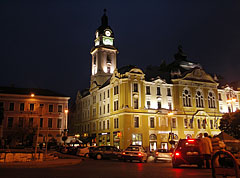
The City Hall by night
Data de fotografia: 20052005
Criado por: Robert Németh
Modelo da câmara: Konica Minolta Dimage A200
Pécs, Hungria
-

The Holy Trinity statue and the mosque behind it
The first Holy Trinity Column ("Szentháromság-szobor") on this place was erected in 1714, the current sculpture was created by György Kiss in 1908.
Data de fotografia: 20062006
Criado por: Robert Németh
Modelo da câmara: Konica Minolta Dimage A200
Pécs, Hungria
-
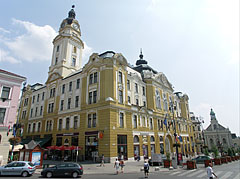
City Hall of Pécs, and the farther on the left
Data de fotografia: 20062006
Criado por: Robert Németh
Modelo da câmara: Konica Minolta Dimage A200
Pécs, Hungria
-

The tower of the City Hall with the clock
Data de fotografia: 20062006
Criado por: Robert Németh
Modelo da câmara: Konica Minolta Dimage A200
Pécs, Hungria
-
Church of the Hospitallers of St. John of God, the eclectic facade, and the decorative Zsolnay Fountain in front of it
Data de fotografia: 20062006
Criado por: Robert Németh
Modelo da câmara: Konica Minolta Dimage A200
Pécs, Hungria
Church of the Hospitallers of St. John of God, the eclectic facade, and the decorative Zsolnay Fountain in front of it - Pécs, Hungria -
Zsolnay fountain (created in 1830 according to the plans of Andor Pich, for the 100th Anniversary of the death of Vilmos Zsolnay)
Data de fotografia: 20062006
Criado por: Robert Németh
Modelo da câmara: Konica Minolta Dimage A200
Pécs, Hungria
Zsolnay fountain (created in 1830 according to the plans of Andor Pich, for the 100th Anniversary of the death of Vilmos Zsolnay) - Pécs, Hungria -
Ox head with iridescent eosin glaze on the Zsolnay fountain
Data de fotografia: 20062006
Criado por: Robert Németh
Modelo da câmara: Konica Minolta Dimage A200
Pécs, Hungria
Ox head with iridescent eosin glaze on the Zsolnay fountain - Pécs, Hungria -
The yellow City Hall with the clocktower
Data de fotografia: 20062006
Criado por: Robert Németh
Modelo da câmara: Konica Minolta Dimage A200
Pécs, Hungria
The yellow City Hall with the clocktower - Pécs, Hungria -
Map of the inner city of Pécs
Data de fotografia: 20062006
Criado por: Robert Németh
Modelo da câmara: Konica Minolta Dimage A200
Pécs, Hungria
Map of the inner city of Pécs - Pécs, Hungria -
Church of the Hospitallers of St. John of God, interior
Data de fotografia: 20092009
Criado por: Robert Németh
Modelo da câmara: Konica Minolta Dimage A200
Pécs, Hungria
Church of the Hospitallers of St. John of God, interior - Pécs, Hungria -
Church of the Hospitallers of St. John of God, the main altar
Data de fotografia: 20092009
Criado por: Robert Németh
Modelo da câmara: Konica Minolta Dimage A200
Pécs, Hungria
Church of the Hospitallers of St. John of God, the main altar - Pécs, Hungria -
The Hospitallers' (Brothers Hospitallers of St. John of God) coat of arms over the gate of their church
Data de fotografia: 20092009
Criado por: Robert Németh
Modelo da câmara: Konica Minolta Dimage A200
Pécs, Hungria
The Hospitallers' (Brothers Hospitallers of St. John of God) coat of arms over the gate of their church - Pécs, Hungria -
Virgin Mary statue on the facade of the Hospitallers' Church, over the gate
It is a copy of a statue that was created by György Kis in 1900.
Data de fotografia: 20092009
Criado por: Robert Németh
Modelo da câmara: Konica Minolta Dimage A200
Pécs, Hungria
Virgin Mary statue on the facade of the Hospitallers' Church, over the gate - Pécs, Hungria -
Eosin glazed bull's head (or ox head) on the Zsolnay Fountain
The fountain was a present from Miklós Zsolnay to the city.
Data de fotografia: 20092009
Criado por: Robert Németh
Modelo da câmara: Konica Minolta Dimage A200
Pécs, Hungria
Eosin glazed bull's head (or ox head) on the Zsolnay Fountain - Pécs, Hungria -
One of the windows of Pasha Qasim's Mosque
Data de fotografia: 20092009
Criado por: Robert Németh
Modelo da câmara: Konica Minolta Dimage A200
Pécs, Hungria
One of the windows of Pasha Qasim's Mosque - Pécs, Hungria -
Oriental patterns over the window of Pasha Qasim's Mosque
Data de fotografia: 20092009
Criado por: Robert Németh
Modelo da câmara: Konica Minolta Dimage A200
Pécs, Hungria
Oriental patterns over the window of Pasha Qasim's Mosque - Pécs, Hungria -
The interior of Pasha Qasim's Mosque
Data de fotografia: 20092009
Criado por: Robert Németh
Modelo da câmara: Konica Minolta Dimage A200
Pécs, Hungria
The interior of Pasha Qasim's Mosque - Pécs, Hungria -
Interior of Pasha Qasim's Mosque (today: Roman Catholic Church of Our Lady of Candlemas)
Data de fotografia: 20092009
Criado por: Robert Németh
Modelo da câmara: Konica Minolta Dimage A200
Pécs, Hungria
Interior of Pasha Qasim's Mosque (today: Roman Catholic Church of Our Lady of Candlemas) - Pécs, Hungria -
Interior of Pasha Qasim's Mosque (currently the Roman Catholic Church of Our Lady of Candlemas)
Data de fotografia: 20092009
Criado por: Robert Németh
Modelo da câmara: Konica Minolta Dimage A200
Pécs, Hungria
Interior of Pasha Qasim's Mosque (currently the Roman Catholic Church of Our Lady of Candlemas) - Pécs, Hungria -
The Mosque of Pasha Qasim; it is clearly visible that the main square is under construction
Data de fotografia: 20092009
Criado por: Robert Németh
Modelo da câmara: Konica Minolta Dimage A200
Pécs, Hungria
The Mosque of Pasha Qasim; it is clearly visible that the main square is under construction - Pécs, Hungria -
The renovated facade of Hotel Nádor
Data de fotografia: 20092009
Criado por: Robert Németh
Modelo da câmara: Konica Minolta Dimage A200
Pécs, Hungria
The renovated facade of Hotel Nádor - Pécs, Hungria -
City Hall (in Hungarian "Városháza")
Data de fotografia: 20092009
Criado por: Robert Németh
Modelo da câmara: Konica Minolta Dimage A200
Pécs, Hungria
City Hall (in Hungarian "Városháza") - Pécs, Hungria -
Clocktower of the City Hall of Pécs
Data de fotografia: 20092009
Criado por: Robert Németh
Modelo da câmara: Konica Minolta Dimage A200
Pécs, Hungria
Clocktower of the City Hall of Pécs - Pécs, Hungria -
The City Hall on the main square, which is under renovation
Data de fotografia: 20092009
Criado por: Robert Németh
Modelo da câmara: Konica Minolta Dimage A200
Pécs, Hungria
The City Hall on the main square, which is under renovation - Pécs, Hungria -
The rounded corner of the County Hall building, with a smaller dome on the top
Data de fotografia: 20092009
Criado por: Robert Németh
Modelo da câmara: Konica Minolta Dimage A200
Pécs, Hungria
The rounded corner of the County Hall building, with a smaller dome on the top - Pécs, Hungria -
Pharmacy to the Saracen (Szerecsen Patika) and Pharmacy Museum in the neo-baroque style corner building
Built in 1897, architect: Imre Schlauch
Data de fotografia: 20092009
Criado por: Robert Németh
Modelo da câmara: Konica Minolta Dimage A200
Pécs, Hungria
Pharmacy to the Saracen (Szerecsen Patika) and Pharmacy Museum in the neo-baroque style corner building - Pécs, Hungria -
A saracen statue on the wall over the door of the Szerecsen Patika ("Pharmacy to the Saracen") (by Gyula Zsolnay, 1898)
Data de fotografia: 20092009
Criado por: Robert Németh
Modelo da câmara: Konica Minolta Dimage A200
Pécs, Hungria
A saracen statue on the wall over the door of the Szerecsen Patika ("Pharmacy to the Saracen") (by Gyula Zsolnay, 1898) - Pécs, Hungria -
Details of the County Hall building: a small balcony with an even smaller tree on it
Data de fotografia: 20092009
Criado por: Robert Németh
Modelo da câmara: Konica Minolta Dimage A200
Pécs, Hungria
Details of the County Hall building: a small balcony with an even smaller tree on it - Pécs, Hungria -
Ceramic decorations on wall of the County House
These were created in the porcelain/china factory of Vilmos Zsolnay in 1898.
Data de fotografia: 20092009
Criado por: Robert Németh
Modelo da câmara: Konica Minolta Dimage A200
Pécs, Hungria
Ceramic decorations on wall of the County House - Pécs, Hungria -
The Jókai Square, viewed from the main square (Széchenyi Square)
Data de fotografia: 20092009
Criado por: Robert Németh
Modelo da câmara: Konica Minolta Dimage A200
Pécs, Hungria
The Jókai Square, viewed from the main square (Széchenyi Square) - Pécs, Hungria -
The "House to the Elephant" on the stone covered square, and the so-called "Great Tree" in front of it
The "Great Tree" is a large-leaved lime (Tilia platyphyllos).
Data de fotografia: 20092009
Criado por: Robert Németh
Modelo da câmara: Konica Minolta Dimage A200
Pécs, Hungria
The "House to the Elephant" on the stone covered square, and the so-called "Great Tree" in front of it - Pécs, Hungria -
The "pedestrianized" Jókai Square
Data de fotografia: 20092009
Criado por: Robert Németh
Modelo da câmara: Konica Minolta Dimage A200
Pécs, Hungria
The "pedestrianized" Jókai Square - Pécs, Hungria -
The yellow Elefántos House ("House to the Elephant") or Tallián House, including the Elefántos Restaurant and Pizzeria
The building was designed by József Piatsek, built in 1830.
Data de fotografia: 20092009
Criado por: Robert Németh
Modelo da câmara: Konica Minolta Dimage A200
Pécs, Hungria
The yellow Elefántos House ("House to the Elephant") or Tallián House, including the Elefántos Restaurant and Pizzeria - Pécs, Hungria -
The romantic style "House to the Elephant" alias Tallián House or Piatsek House (with a restaurant and pizzeria on its ground floor)
Data de fotografia: 20092009
Criado por: Robert Németh
Modelo da câmara: Konica Minolta Dimage A200
Pécs, Hungria
The romantic style "House to the Elephant" alias Tallián House or Piatsek House (with a restaurant and pizzeria on its ground floor) - Pécs, Hungria -
A tin elephant statue at the corner of the "House to the Elephant" ("Elefántos Ház")
Data de fotografia: 20092009
Criado por: Robert Németh
Modelo da câmara: Konica Minolta Dimage A200
Pécs, Hungria
A tin elephant statue at the corner of the "House to the Elephant" ("Elefántos Ház") - Pécs, Hungria -
The so-called Millenium Mamorial Fountain in the middle of the square
Data de fotografia: 20092009
Criado por: Robert Németh
Modelo da câmara: Konica Minolta Dimage A200
Pécs, Hungria
The so-called Millenium Mamorial Fountain in the middle of the square - Pécs, Hungria -
"Terrace" of the Goldmark Café
Data de fotografia: 20092009
Criado por: Robert Németh
Modelo da câmara: Konica Minolta Dimage A200
Pécs, Hungria
"Terrace" of the Goldmark Café - Pécs, Hungria -
The "House to the Elephant" and the terrace of the Barrus Hungarian Restaurant
Data de fotografia: 20092009
Criado por: Robert Németh
Modelo da câmara: Konica Minolta Dimage A200
Pécs, Hungria
The "House to the Elephant" and the terrace of the Barrus Hungarian Restaurant - Pécs, Hungria -
A trickling "brook" from the "Millennium Memorial Fountain" in the square
Data de fotografia: 20092009
Criado por: Robert Németh
Modelo da câmara: Konica Minolta Dimage A200
Pécs, Hungria
A trickling "brook" from the "Millennium Memorial Fountain" in the square - Pécs, Hungria -
"House to the Elephant" ("Elefántos Ház"), a window of the Barrus Restaurant
Data de fotografia: 20092009
Criado por: Robert Németh
Modelo da câmara: Konica Minolta Dimage A200
Pécs, Hungria
"House to the Elephant" ("Elefántos Ház"), a window of the Barrus Restaurant - Pécs, Hungria -
The Lóránt Palace or Lőwy Palace, viewed from Jókai Square
Designed by Adolf Morgenstern architect from Budapest, built in 1883.
Data de fotografia: 20092009
Criado por: Robert Németh
Modelo da câmara: Konica Minolta Dimage A200
Pécs, Hungria
The Lóránt Palace or Lőwy Palace, viewed from Jókai Square - Pécs, Hungria -
The Lóránt Palace with a pharmacy on its ground floor
Data de fotografia: 20092009
Criado por: Robert Németh
Modelo da câmara: Konica Minolta Dimage A200
Pécs, Hungria
The Lóránt Palace with a pharmacy on its ground floor - Pécs, Hungria -
A violet-painted part of the Elefántos House ("House to the Elephant")
Data de fotografia: 20092009
Criado por: Robert Németh
Modelo da câmara: Konica Minolta Dimage A200
Pécs, Hungria
A violet-painted part of the Elefántos House ("House to the Elephant") - Pécs, Hungria -
Elefántos Restaurant, a dish of tasty Italian penne pasta with ham and cream
Data de fotografia: 20092009
Criado por: Robert Németh
Modelo da câmara: Konica Minolta Dimage A200
Pécs, Hungria
Elefántos Restaurant, a dish of tasty Italian penne pasta with ham and cream - Pécs, Hungria -
The Jókai Square pedestrian area in the evening
Data de fotografia: 20052005
Criado por: Robert Németh
Modelo da câmara: Konica Minolta Dimage A200
Pécs, Hungria
The Jókai Square pedestrian area in the evening - Pécs, Hungria -
Sign of Szabó Marzipan Manufactory
Data de fotografia: 20052005
Criado por: Robert Németh
Modelo da câmara: Konica Minolta Dimage A200
Pécs, Hungria
Sign of Szabó Marzipan Manufactory - Pécs, Hungria -
A huge triple decker wedding cake in the shop window of Szabó Marcipán (or Szabó Marzipan)
Data de fotografia: 20052005
Criado por: Robert Németh
Modelo da câmara: Konica Minolta Dimage A200
Pécs, Hungria
A huge triple decker wedding cake in the shop window of Szabó Marcipán (or Szabó Marzipan) - Pécs, Hungria -
Mosque of Pasha Qasim, made of marzipan (marchpane)
Data de fotografia: 20052005
Criado por: Robert Németh
Modelo da câmara: Konica Minolta Dimage A200
Pécs, Hungria
Mosque of Pasha Qasim, made of marzipan (marchpane) - Pécs, Hungria -
Enormous, 2.4 meters tall giant wedding cake, made of 1400 eggs
Created by Mr. Károly Szabó and Mrs. Zsuzsanna Makai Láposi
Data de fotografia: 20052005
Criado por: Robert Németh
Modelo da câmara: Konica Minolta Dimage A200
Pécs, Hungria
Enormous, 2.4 meters tall giant wedding cake, made of 1400 eggs - Pécs, Hungria -
Realistic marzipan pillows
Data de fotografia: 20052005
Criado por: Robert Németh
Modelo da câmara: Konica Minolta Dimage A200
Pécs, Hungria
Realistic marzipan pillows - Pécs, Hungria -
Small furniture and cushions made of marzipan (marchpane)
Data de fotografia: 20052005
Criado por: Robert Németh
Modelo da câmara: Konica Minolta Dimage A200
Pécs, Hungria
Small furniture and cushions made of marzipan (marchpane) - Pécs, Hungria -
"Fairyland" from marchpane: a scene from "János Vitéz" ("John the Vaillant"), a poem or poetic tale of Sándor Petőfi
Data de fotografia: 20052005
Criado por: Robert Németh
Modelo da câmara: Konica Minolta Dimage A200
Pécs, Hungria
"Fairyland" from marchpane: a scene from "János Vitéz" ("John the Vaillant"), a poem or poetic tale of Sándor Petőfi - Pécs, Hungria -
Marzipan portraits of historical celebrities of Hungary (the picture frames are also made of marzipan)
Data de fotografia: 20052005
Criado por: Robert Németh
Modelo da câmara: Konica Minolta Dimage A200
Pécs, Hungria
Marzipan portraits of historical celebrities of Hungary (the picture frames are also made of marzipan) - Pécs, Hungria -
Lifelike marzipan figure of Elvis Presley
Although he's not fat yet, he already weighs 103 kilograms, and in addition he is 2.13 meters tall.
Data de fotografia: 20052005
Criado por: Robert Németh
Modelo da câmara: Konica Minolta Dimage A200
Pécs, Hungria
Lifelike marzipan figure of Elvis Presley - Pécs, Hungria -
Lace made of marzipan (or marchpane in other world)
Data de fotografia: 20052005
Criado por: Robert Németh
Modelo da câmara: Konica Minolta Dimage A200
Pécs, Hungria
Lace made of marzipan (or marchpane in other world) - Pécs, Hungria -
The worldwide unique realistic marchpane cactuses
It was created by Mrs. Marika Garamszegi master confectioner, during one year.
Data de fotografia: 20052005
Criado por: Robert Németh
Modelo da câmara: Konica Minolta Dimage A200
Pécs, Hungria
The worldwide unique realistic marchpane cactuses - Pécs, Hungria -
Bouquet of carnation flowers made of marzipan (marchpane)
Data de fotografia: 20052005
Criado por: Robert Németh
Modelo da câmara: Konica Minolta Dimage A200
Pécs, Hungria
Bouquet of carnation flowers made of marzipan (marchpane) - Pécs, Hungria
Clique nas imagens!
Características, propriedades
Localização:
Coordenadas GPS: Latitude 46°4'34", Longitude 18°13'40" (N46 4.57 - E18 13.67)
Informações, histórias curtas, fatos interessantes
 Mosque of Pasha Qasim (today Roman Catholic Church, formerly called St Bartholomew's Church) by night
Mosque of Pasha Qasim (today Roman Catholic Church, formerly called St Bartholomew's Church) by night
Although it is somewhat a cliché it is still true that the Mosque of Pasha Qasim (the present-day Downtown Candlemas Church of the Blessed Virgin Mary) is one of the gems of the Turkish-Islamic architecture in Hungary. This islamic place of worship was built during the 150-year-long Turkish occupation of Hungary, in the place of an old Christian church (the St. Bartholomew's Church, in Hungarian "Szent Bertalan-templom"). After it was in Hungarian hands again it was rebuilt to a Catholic church, but despite it the Islamic architectural character remained relatively intact. To reach again a similar appearance as in the Ottoman era, in 1956 the architects replaced the former slightly pointed (so-called Florentine style) dome of the church with a lower hemispherical one. This more closely resembles the dome of the original mosque.
 Interior of Pasha Qasim's Mosque (currently the Roman Catholic Church of Our Lady of Candlemas)
Interior of Pasha Qasim's Mosque (currently the Roman Catholic Church of Our Lady of Candlemas)
The Pasha Qasim's Mosque was built in place of the 13th-century St. Bartholomew's Church during the Ottoman rule of Hungary around the 1560s, probably by using the stones of the old Christian church. After Hungary was liberated from Turkish rule the church was acquired by the Roman Catholic Jesuit Order. In 1702 the turkish mosque was converted to Christian church, as well as in 1766 the ruined minaret was also demolished.
As the time went on there were more significant alterations, the las one was done in 1939. At that time among other things the annexed baroque tower (which was built around 1770) was demolished, and in place of it the current semicircular part of the building was built by the plans of Nándor Körmendy. The large murals on the wall inside the new "wing" were created by Ernő Gebauer in 1947.
 The renovated facade of Hotel Nádor
The renovated facade of Hotel Nádor
The Hotel Nádor on the main square of Pécs is actually the second hotel building here with the same name. The Hotel Nádor was built in 1845, it was named after Archduke Joseph, Palatine of Hungary from the Habsburg family (the Hungarian word "nádor" means "palatine"). This relatively simple neoclassical style three-storey hotel with its 30 nicely furnished rooms was the royal and imperial headquarters during the Hungarian Revolution and Independence War of 1848-1849.
After some time the first Hotel Nádor became outdated and obsolate, so in 1902 a new Art Nouveau style building was built by the plans of architect Imre Schlauch, and this can be seen today. The 75-room new hotel took more space from the main square, so the traffic was moved to the other side of the square.
The culmination of the story of the second Nádor Hotel arrived around the 1920s, when it got a new owner and was united with the Hotel Pannónia (the present-day Hotel Palatinus). The Hotel Nádor was a real luxury hotel, equipped both with expensive fixtures and decors, as well as technological innovations (e.g. electric lighting and central heating). In addition, there was an openable dome roof over its 220-person-capacity restaurant.
The post-World War II communist era brought deprivatization for the hotel, but within its walls the sparkling, lively social life still remained. Many famous Hungarian actors and writers were frequent guests here, they spent pleasant days and weeks here. In 1961 the hotel was extended with a confectionery, too.
Unfortunately the second Hotel Nádor was also outdated over time, slowly it became obsolete and it was closed in 1989. In 1999 it was acquired by the Danubius Hotels Group hotel chain, and the building was nicely renovated and modernized at least from outside. For example it received an underground parking garage and also an art gallery was opened within its walls. However, the complete renovation of the interior still haven't done, so today (in 2013) it cannot operate as a hotel, yet.
Pécs - Mais galerias de fotos:
Você também pode estar interessado (Páginas relacionadas):
Destinos em o guia de viagem:
Pécs (225 fotos + 3 imagens panorâmicas)
Mecsek Mountains (304 fotos + 3 imagens panorâmicas)
Baranya megye (county) (857 fotos + 4 imagens panorâmicas)
Transdanúbia Meridional (Dél-Dunántúl) (1 597 fotos + 8 imagens panorâmicas)
Hungria (27 287 fotos + 163 imagens panorâmicas)
e adicionalmente:
(dentro aqui: Mecsek Mountains)
Abaliget (10 fotos)
Magyaregregy (69 fotos)
Orfű
Püspökszentlászló
Cada foto panorama aqui:
Pécs (3 fotos)
Baranya megye (county) (4 fotos)
Transdanúbia Meridional (Dél-Dunántúl) (8 fotos)
Hungria (163 fotos)
Europa (165 fotos)
Cada fotos normais aqui:
Pécs (225 fotos / 4 galerias)
Mecsek Mountains (304 fotos / 6 galerias)
Baranya megye (county) (857 fotos / 17 galerias)
Transdanúbia Meridional (Dél-Dunántúl) (1 597 fotos / 32 galerias)
Hungria (27 287 fotos / 462 galerias)
Europa (30 494 fotos / 523 galerias)
https://www.panadea.com/pt/guidebook/pecs/photos/gal-001

Adicionar aos Favoritos Adicionar aos Favoritos
Compartilhe com seus amigos!
etc.
Sobre nós - Advertência jurídica -
Todos os direitos reservados
- ©2010-2022
Neuronit Creative Studio - Mogyoród / Budapeste / Hungria





